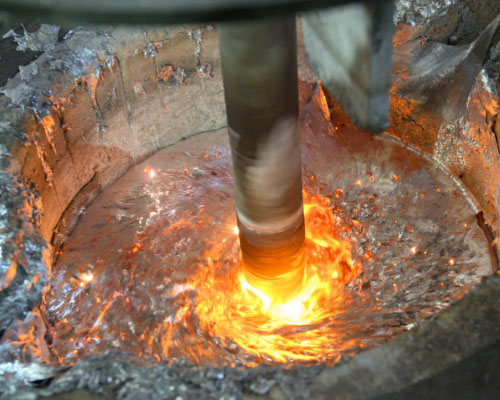Nitrogen degassing machine is used to control the content of hydrogen, alkali metal and inclusion in aluminum melt before casting.
In the past 20 years, the nitrogen degassing for aluminum has been developed comprehensively.
The solubility and influencing parameters of hydrogen always interact with the atmosphere, thus forming an equilibrium between gaseous hydrogen in air and hydrogen in aluminum melt. But the partial pressure (or content) of hydrogen in the atmosphere is almost irrelevant. Therefore, hydrogen comes from water vapor in the atmosphere, which easily reacts with liquid aluminum to produce two problematic reaction products, namely alumina (inclusions) and hydrogen (gas).
The problem that aluminum has hydrogen is not because it is particularly soluble in liquid aluminum, but because it is particularly insoluble in solid aluminum, so aluminum will precipitate from the solution during solidification. The aluminum nitrogen degassing machine needs to remove hydrogen from the melt before purging the melt with inert gas nitrogen.

Understanding the mechanism of hydrogen removal is very important to determine and influence the factors affecting the best removal method.
Atomic hydrogen is dissolved in liquid aluminum and evenly distributed. When the dry inert bubbles are introduced into the melt, the internal hydrogen partial pressure is almost zero. In the nitrogen bubble, a local equilibrium is rapidly established between the H concentration and the H partial pressure in the melting boundary layer. The diffusion rate of hydrogen from the human body to the boundary layer is limited, and the recombination of hydrogen from atom to molecule is very fast. The hydrogen concentration in the bubbles increases as they rise to the surface of the melt. The hydrogen transfer rate is not only related to the diffusion rate, but also to the total area of the bubble interface. A given inert gas flow has a larger interface area and can accommodate smaller bubbles.
In addition, with the decrease of bubbles, the residence time of each bubble in the melt becomes longer. This is because the terminal velocity decreases, which makes the hydrogen transport time longer. Deeper reaction zones allow more time to reach equilibrium because bubbles stay in the melt longer before reaching the surface. Therefore, the aluminum nitrogen degasser needs to produce minimum bubbles at the bottom of the treatment vessel.
This is achieved at high rotor speeds. The melt is also mixed to obtain a uniform hydrogen distribution. Spray gun processing is the beginning of industrial degassing, but the spray gun usually produces large bubbles with diameters between 10 and 50 mm. The bubble size is widely distributed and the melt homogeneity is limited. The porous bricks, whether connected to the lance outlet or furnace bottom, will produce fine bubbles with a diameter of 10 to 20 mm, but even with them, homogenization and bubble distribution are not optimal. Finally, the development of the rotary jet system with rotor solved the problem of insufficient gas distribution and provided bubbles with diameters in the range of 3-10 mm.

